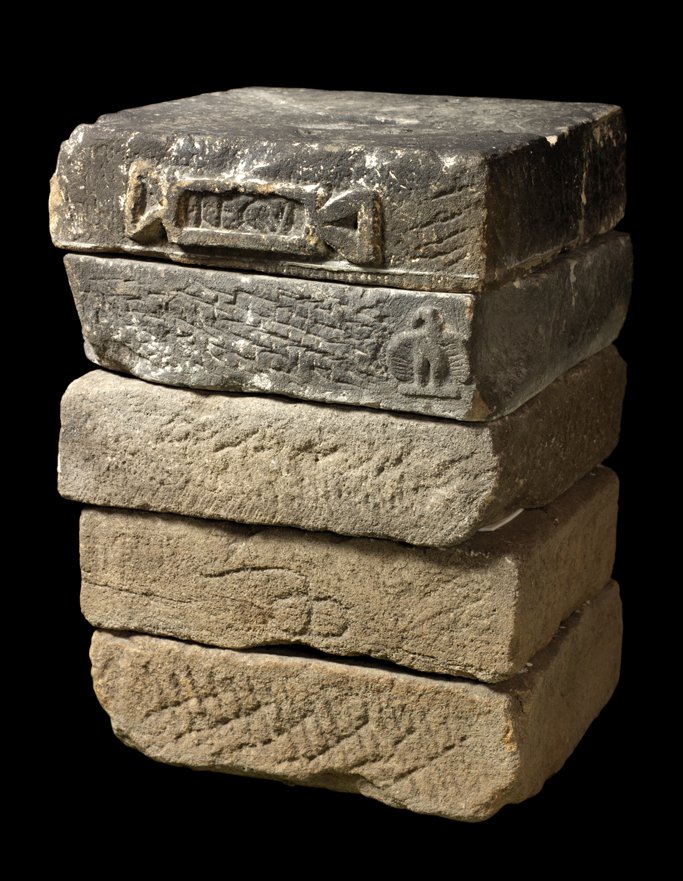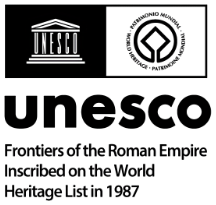Pier-stone activity
This activity is aimed at schools & families to help discover the wonder of Roman objects in our collection
Pier-stone

These large rectangular stones were used in piers (square pillars) in the forecourt of the first headquarters building (principia, Latin for headquarter) in the fort. When the forecourt was later demolished the stones were re-used elsewhere in the fort and so far, we have found over 70 of them scattered around. One example has an inscription ‘LEG VI’(Latin for Legion & Roman numeral 6**) inside a decorative border, carved by the Sixth Legion who built the fort, and one has an eagle. As a bird of prey striking down its enemies, the eagle was a popular symbol of the military, but it was also a representation of power, since it was associated with the chief god, Jupiter, and with emperors. For more about the eagle, see week 4 in this series.
The carving of stone is called Masonry and would be done by skilled engineers or workmen. A variety of tools such as picks, axes, and chisels which would have been struck with a mallet or hammer were used.
**FUN FACT: Did you know that the Romans didn’t have a symbol for the number zero (0). The Roman Numerals System was developed for mostly knowing the price of goods, and to trade. There was no need for a symbol to represent zero as the Romans used the word “nulla” (the Latin word meaning "none") instead.
Activities
Take a good look at these pier stones
What do you see, notice and wonder about them? How tall do you think the pillars might have been? How many stones do you think were used in a pillar? What do you think they were supporting? Can you think of some structures that use pillars today?
Now it’s your turn
Using items you can find around the house build a pillar. Try it with a friend or family member. Have a race to see who can build the tallest, strongest, or widest. You can use blocks, lego, toilet rolls, paper tubes, rolled paper, books, etc. Let your imagination run wild!
Next why not find some smooth stones and make your own pet rock or rock art. The Romans carved their pictures, but you can paint, or use coloured markers to create yours.
Learning extension
You are the commanding officer at Arbeia Roman Fort and you must send an urgent message to Vindolanda, another Roman fort along Hadrian's wall. This message must be kept secret. Write your secret message in Roman numeral code. Share your work with a classmate and see if they can decode it. Here is a chart to help.
| Number | Roman Numeral/letter | Calculation |
|---|---|---|
| 0 | not defined | |
| 1 | I/A | 1 |
| 2 | II/B | 1+1 |
| 3 | III/C | 1+1+1 |
| 4 | IV/D | 5-1 |
| 5 | V/E | 5 |
| 6 | VI/F | 5+1 |
| 7 | VII/G | 5+1+1 |
| 8 | VIII/H | 5+1+1+1 |
| 9 | IX/I | 10-1 |
| 10 | X/J | 10 |
| 11 | XI/K | 10+1 |
| 12 | XII/L | 10+1+1 |
| 13 | XIII/M | 10+1+1+1 |
| 14 | XIV/N | 10-1+5 |
| 15 | XV/O | 10+5 |
| 16 | XVI/P | 10+5+1 |
| 17 | XVII/Q | 10+5+1+1 |
| 18 | XVIII/R | 10+5+1+1+1 |
| 19 | XIX/S | 10-1+10 |
| 20 | XX/T | 10+10 |
| 21 | XXI/U | 10+10+1 |
| 22 | XXII/V | 10+10+1+1 |
| 23 | XXIII/W | 10+10+1+1+1 |
| 24 | XXIV/X | 10+10-1+5 |
| 25 | XXV/Y | 10+10+5 |
| 26 | XXVI/Z | 10+10+5+1 |
More online activities to enjoy
Unfortunately at this current time we can not offer our full family programmes in the museums but we have created lots of online learning activities for you to enjoy.
More online activities from our venues:
Segedunum Roman Fort
Find out about Marvellous Mondays : Home from Segedunum Collections.
South Shields Museum & Art Gallery
Take part in Take One Treasure Challenge - activities inspired by the museum collection.




